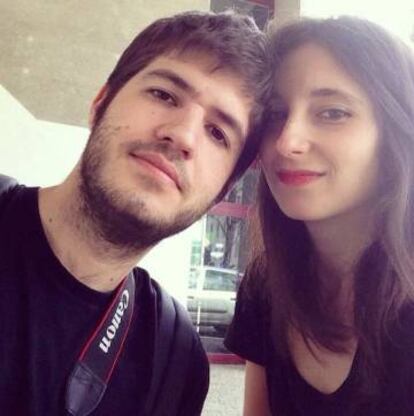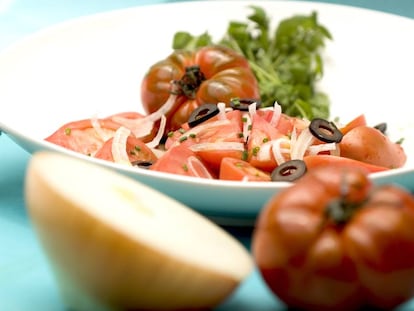I have celiac disease, my girlfriend is vegan, and we’ve heard all the jokes already
On our first date, I told my girlfriend, “we’ll never have dinner together”

The same night I kissed my girlfriend for the first time, I told her: “We’re never going to eat dinner together.” The story has a happy ending, we currently live together with three cats and are trying to win the lottery to see if we can buy a better apartment, but there’s a good reason why I told her this – other than the fact that I am not a great seducer.
I have Celiac disease. I’m 28 years old and I’ve had it since I was two. I’m part of the old school of gluten intolerance – those people who could only eat disgusting bread found in certain herb shops when they were little (I’ve seen bread rolls you wouldn’t believe). Until that night, I thought vegans were stupid people, who being able to eat whatever they wanted, chose not to, a luxury that people with my condition don’t have. I was wrong.
I thought vegans were stupid people. I was wrong
My girlfriend Laura is 29 years old and she is a vegan, but she isn’t the tree-hugging, homeopathic type of vegan who expects pats on the back. She is a vegan for political reasons. She is a vegan solely for animal rights. She says we are massacring animals and animals need to be protected. While you complain about bullfighting in arenas, you’re okay with eating the cow if it’s on your plate, she says. Laura believes that, just like any other kind of oppression, in order to fight it you have to take a side, and veganism is the first step in defending animals.
Obviously, my warning did not come true and we have since shared many meals together. At first it was hard to know what restaurants we could both eat at. On one occasion, we asked for so many things to be taken out as we were ordering at a restaurant that the waitress began to look at us strangely. In a playful tone, I listed everything we were intolerant to and she couldn’t refrain from saying: “That’s a bummer.” A heavy blow for us both. Needless to say, she didn’t get tipped.
Over time, we began to work out what we could eat together. This, combined with the advantage of living in a big city like Madrid, has let us find restaurants and take-out options for almost every celiac or vegan craving we get. And this we owe to you, Google. Thank you.
Laura knows how to answer for me the classic, “what happens if you eat a piece of bread?
Our friends began to make fun of us. It was only a matter of time. They come from different friendship groups but all have a great sense of humor. They saw a relationship between someone with celiac disease and a vegan as a comedy diamond in the rough that needed to be polished with jokes. At first they were cautious with their jabs, but they quickly realized they could let rip. They have a vast repertoire – from jokes in the style of Spanish comedian Bertín Osborne like: “What do you eat together? Water?” To offering us tapas with bread and chorizo on top, knowing well that neither us can eat it. They wish us a beautiful wedding and say they will order Chinese food before the reception. They even ask: “Are the weirdos coming?” when friends in our WhatsApp group try to organize a meal.
The relationship started getting serious and we decided to move in together. Spending more time together means we are present every time either one of us gets questions about our diet, so much so that Laura knows how to answer for me when I get the classic: “What happens if you eat a piece of bread?” And I know how to respond when she is asked: “But why eggs and milk? No animal is getting killed in the process.”
At home, despite our particular food situation, we are like any ordinary couple: we have a Poäng armchair from IKEA in the living room, we watch Operación Triunfo (a Spanish TV singing competition) and invite people over to eat in our home. At first they were doubtful, but if the meal doesn’t work out, it’s less about ingredients we have used and more because we aren’t the best cooks.
“How are you going to invite people over to have dinner if you can’t eat anything?” you might be thinking, dear reader. I understand that this might be your first thought, because it was also mine. But this is not the case.
How are you going to invite people over to have dinner if you can’t eat anything?
When the fridge empties out, we do our groceries at a big supermarket like any average joe. There we find almost everything. First we look for things that we can both eat, such as fruit, vegetables, beans, etc., then we focus on specific things for each of us. Our shopping cart ends up with miscellaneous goods: the vegan cheese and tofu sit next to the beer and gluten-free cookies. The gluten-free bread faces the seitan, specifically made of wheat gluten, like Superman looking at kryptonite. Sometimes we have guest stars, rare species we can both eat but rarely find, such as olive pâté or gluten-free soy sauce.
When we get to the checkout, we split the costs evenly, although I’m the one who drives up the cost. Gluten-free products are much more expensive, often four or five times more, than normal cookies. Products made for vegans, on the other hand, are always cheaper than their meat, fish, cheese, or eggs equivalent. Being gluten-intolerant costs money. Being vegan, effort.
Since the only thing stopping fun is money, we try to travel whenever we can. People tend to think that going abroad automatically makes the issue of food harder, and most times this isn’t true. Plenty of cities in Europe have a great variety of celiac and vegan options in their restaurants and supermarkets. You just have to be a little forward-thinking and use Google to find places beforehand.
So dear reader, if you are one of those people who lives on a special diet, be it for moral principals or a medical condition, don’t hesitate to fall in love with someone who is in the same position. You’ll never have to feel silly when stopping to read the ingredients label, or when asking the waiter far too many questions. You’ll protect each other from mixing up your own foods and smile when either of you find a dish you can’t eat, because you’ll know exactly how it feels.
English version by Laura Rodríguez.
Tu suscripción se está usando en otro dispositivo
¿Quieres añadir otro usuario a tu suscripción?
Si continúas leyendo en este dispositivo, no se podrá leer en el otro.
FlechaTu suscripción se está usando en otro dispositivo y solo puedes acceder a EL PAÍS desde un dispositivo a la vez.
Si quieres compartir tu cuenta, cambia tu suscripción a la modalidad Premium, así podrás añadir otro usuario. Cada uno accederá con su propia cuenta de email, lo que os permitirá personalizar vuestra experiencia en EL PAÍS.
¿Tienes una suscripción de empresa? Accede aquí para contratar más cuentas.
En el caso de no saber quién está usando tu cuenta, te recomendamos cambiar tu contraseña aquí.
Si decides continuar compartiendo tu cuenta, este mensaje se mostrará en tu dispositivo y en el de la otra persona que está usando tu cuenta de forma indefinida, afectando a tu experiencia de lectura. Puedes consultar aquí los términos y condiciones de la suscripción digital.
More information
Archived In
Últimas noticias
David Bowie, the galactic thinker who encouraged us to break new ground
John Berger and the loss of rural culture
From police officer to bloodthirsty kidnapper: Terror in Mexico during the years of ‘The Ear Chopper’
Alain Aspect, Nobel laureate in physics: ‘Einstein was so smart that he would have had to recognize quantum entanglement’
Most viewed
- David King, chemist: ‘There are scientists studying how to cool the planet; nobody should stop these experiments from happening’
- Reinhard Genzel, Nobel laureate in physics: ‘One-minute videos will never give you the truth’
- Oona Chaplin: ‘I told James Cameron that I was living in a treehouse and starting a permaculture project with a friend’
- Mexico completes its trade shift with the entry into force of tariffs on China and countries without trade agreements
- Sinaloa Cartel war is taking its toll on Los Chapitos










































